Capacity planning is an issue of supply and demand: one that can decide the fate of your project or business. Read on to learn about the resource capacity planning strategies and best practices you can use to allocate resources efficiently.
What Is Resource Capacity?
Resource capacity is the total amount of work that can be achieved with the resources available to an organization. Understanding this allows decision-makers to determine if there are sufficient resources to execute projects or operational activities.
This concept or resource capacity planning applies to virtually any organization from industries such as construction, manufacturing, IT and professional services, just to name a few.
When managing the resource capacity of a project, business or nonprofit, it’s important to consider the gap between the design capacity and the effective capacity of the organization.
- Design capacity: The total amount of work or deliverables that can be produced using the full capacity of resources such as labor, equipment, machinery and other capital assets
- Effective capacity: The actual resource capacity of an organization at a given point in time, considering that a portion of its total design capacity is being utilized
What Is Capacity Planning?
Capacity planning or resource capacity planning, is the process of ensuring an organization has enough resources to operate, execute projects, and meet increasing customer demand.
Depending on the organization, there can be multiple roles that are given the responsibility of managing the resource capacity, which could go from executives to department managers but ideally, the capacity planning process should be overseen by an individual who specializes in this area, known as capacity planner.
ProjectManager is the one project management software that has everything you need for capacity planning. With robust Gantt charts and resource management tools, you can build a project schedule that incorporates real-time team availability. Your team can then execute the work in multiple views and you can track what matters with dashboards and project reports. Get started today for free.
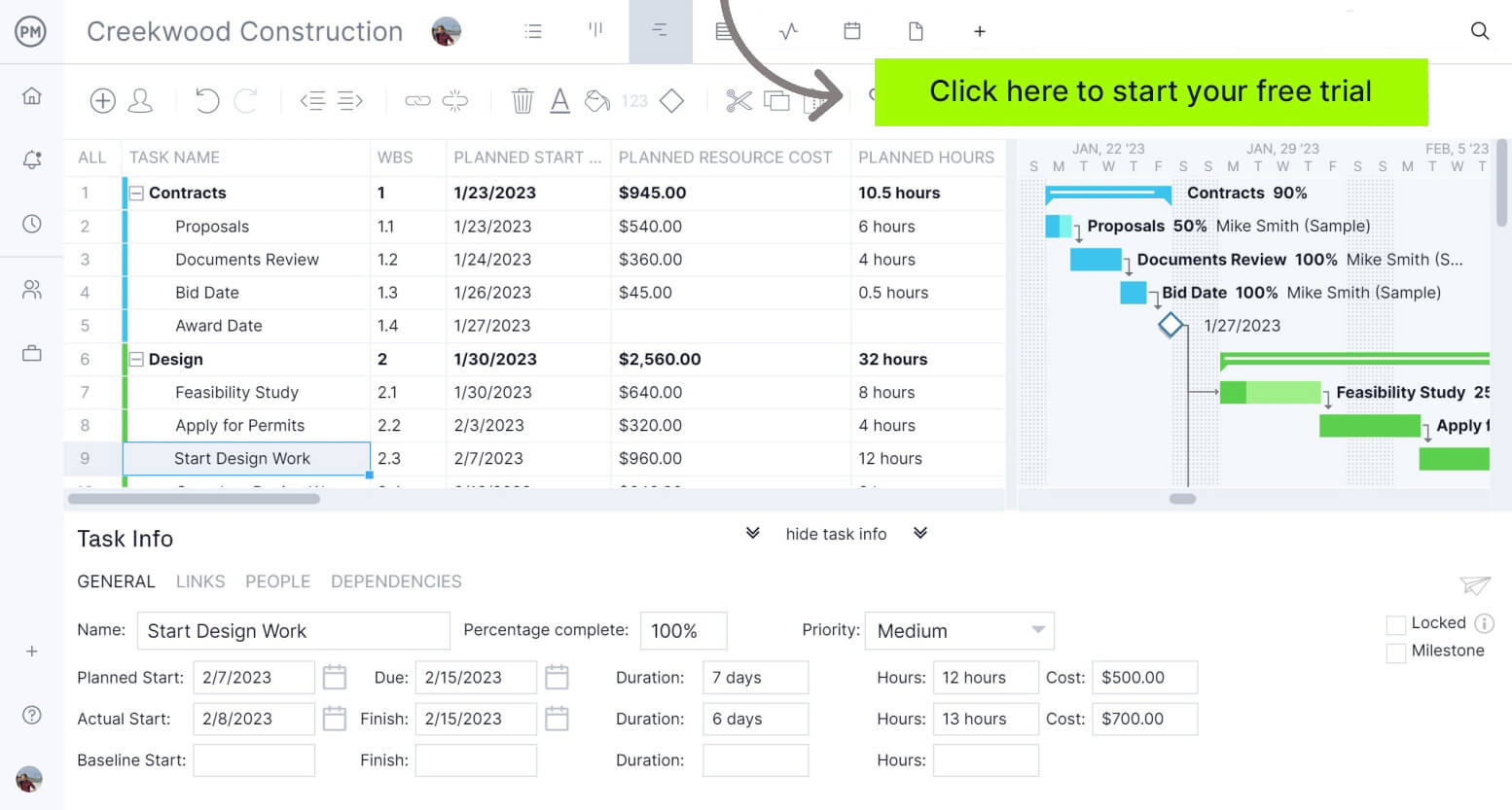
Types of Capacity Planning
Many types of capacity planning approaches allow organizations to be prepared to face the unique challenges of their industry.
Project Capacity Planning
In project management, capacity planning consists of ensuring the organization’s resource capacity is sufficient to cover the resource requirements of a project throughout its execution.
If that’s not the case, the organization might choose to acquire more resources, choose a longer project timeline or simply execute a more feasible project.
The capacity planning process is important when managing projects because of its impact on critical project management knowledge areas such as:
- Resource management
- Time management
- Team management
- Work management
Process Capacity Planning
Process capacity is the maximum output that can be generated by a process within a given timeline. This applies to all the activities that make up the operations of an organization. For example, a manufacturer needs to know the processing capacity of each of the industrial processes that are needed to manufacture a product such as cutting, painting or molding.
Calculating this helps organizations monitor the productivity of each of their business processes, improve them and understand their limitations when starting new projects.
Production Capacity Planning
This type of capacity planning allows manufacturers to determine what level of resource capacity is required to make the production volume needed to meet customer demand.
It also helps them clearly understand the maximum number of product units that can be manufactured with the currently available resources so they know what projects they can take on.
Team Capacity Planning
Team capacity planning, also known as staff capacity, workforce capacity or workload capacity planning, deals with your human resources. It requires you to figure out the total hours employees will need to work to achieve a particular goal or objective.
To find this number, multiply the number of workers you have on the project by the number of hours they work per week.
Tool Capacity Planning
Tool capacity planning helps to forecast how many resources you’ll need and how to allocate those resources at the right time. In short, it makes sure you have the right tools and the right amount of tools necessary to do your job. These tools can include machinery, vehicles, assembly line parts, etc.
Sales Capacity Planning
As its name suggests this type of capacity planning is specific to sales teams, and it refers to the estimated number of employees that are required to reach a sales goal.
There are many variables to consider when estimating the optimal sales capacity but in general terms, the best way to calculate this is to use business data analytics to study historic data.
Agile Capacity Planning
Agile is a project management methodology that allows teams to plan projects in short iterations of work of one or two weeks known as sprints, as opposed to making one project plan as in most cases.
During those sprints, each team member will work on a specific part of the project, which involves resource capacity planning. In this case, the resources are each project team member and any supplies they might need to execute their tasks. This helps project managers make sure nobody is given more work than can be accomplished.
Luckily, regardless of the type of capacity planning, the process is the same for most organizations and projects. Let’s go through some simple capacity planning steps anyone can use.
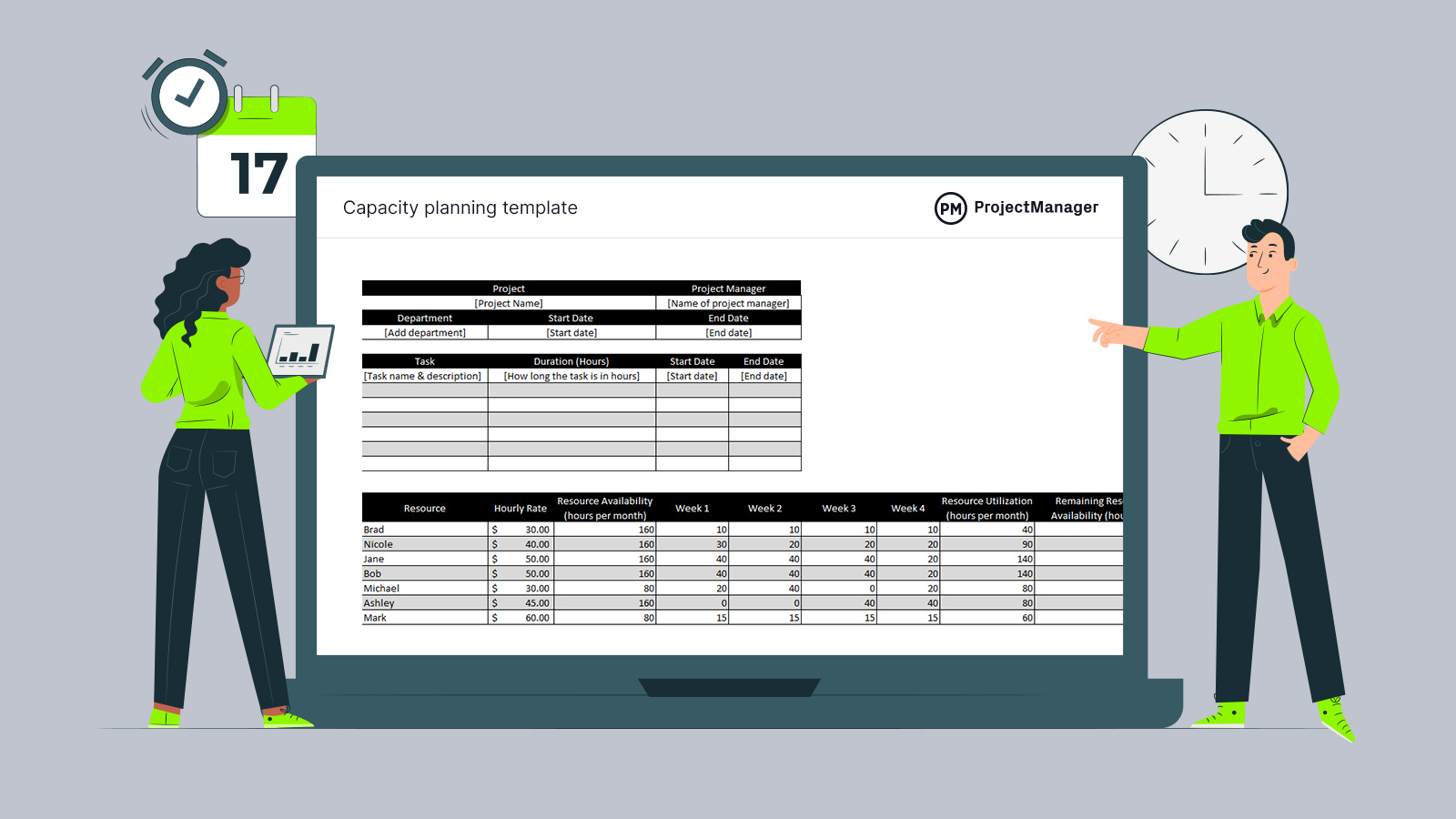
Get your free
Capacity Planning Template
Use this free Capacity Planning Template for Excel to manage your projects better.
Capacity Planning Process
We’ve explained what capacity planning is and why it’s important. The next step is to understand the process. Capacity planning is done differently across companies and industries, but it always follows these four basic steps.
Capacity Analysis
The first step in the capacity planning process is to assess the resource capacity of an organization. To do this, first, establish its design capacity and its effective capacity for a clear picture of what resources are available and what can be done with them.
Capacity Forecasting
Once the capacity of an organization has been established, it’s important to compare it against its project resource requirements or customer demand forecasts to ensure there will be enough resources available for the execution of projects and operational activities. Use expert advice, historical data and anything else that’ll help you know the capacity you need to complete future projects.
Capacity Modeling
As stated above, it’s important to develop a capacity model, which is an action plan that describes the procedures, guidelines and strategies that an organization will use to manage its resource capacity.
Capacity Scheduling
Once you’ve forecasted capacity, you’ll begin the process of creating a production plan. It should include all operations needed to meet customer demand. To do this means scheduling resources, whether raw materials, labor, machinery, etc., to ensure you have the resources needed to complete the project.
Capacity Tracking
To keep to your capacity schedule, you’ll need to track your resources as you go into production. This involves monitoring your non-human resources and making sure you have the inventory needed for the jobs coming up, but also knowing the availability of your human resources so they can be assigned work to complete those orders.
Capacity Reporting
To help with tracking and keeping stakeholders informed of progress, capacity reporting is necessary. A capacity report shows the capacity to deliver and take on new work. These metrics are shown in hours or as a percentage. Reports will also compare your planned capacity with your actual capacity to help you stay on track.
What Does a Capacity Planner Do?
Capacity planning is usually the responsibility of a capacity planner. They’re the ones who plan, analyze, balance and allocate resources as needed to meet the requirements and priorities of the organization. They also respond to customer demand, determining the workforce and timeframe of production to meet that demand.
Depending on the size of the organization, this position can be folded into a project manager’s responsibilities. If it’s a standalone position, however, the capacity planner works with the executive team and other stakeholders. They require excellent communication skills to work well with these different departments.
The capacity planner is a results-oriented person, with strong statistical and reporting skills. They have to collect and understand project data as well as know the trends that are impacting their industry to do their job well.
Besides overseeing the capacity planning process, the capacity planner is also responsible for developing a capacity strategy, a capacity plan and a capacity model for an organization or project. Read on to learn more about each of these important capacity management concepts.
Capacity Planning Strategies
There are three capacity planning strategies to help you meet demand, cover your resource requirements and increase your team members’ productivity.
Lag Strategy
The lag strategy consists of having enough resources to meet actual demand, not projected demand estimates. This capacity planning strategy benefits smaller organizations that have low capacity requirements.
Lead Strategy
The lead strategy consists of having enough resources to meet demand planning forecasts. This capacity planning strategy is beneficial when demand increases, as your excess capacity can cover the increased demand.
Match Strategy
This strategy is a mix of the lead and lag capacity planning strategies. In this case, project managers need to monitor actual demand, demand planning forecasts and market trends to adjust capacity accordingly.
What Is a Capacity Plan?
A capacity plan is used to achieve the goals of the overall capacity planning of an organization. One of the purposes of a capacity plan is that it can help to avoid scope creep in a project. Scope creep is when the requirements of a project increase over time.
When you create a capacity plan for one project, it can often be used as a template for other projects you’re planning. It helps you quickly identify what you do and don’t need, rather than trying to always go back to forecasting capacity requirements from scratch.
Since capacity planning is about the supply and demand of resources, your capacity plan can help you know when demand will increase or decrease so you can adjust the plan accordingly. Your capacity plan and resource plan will be very much related.
What Is a Capacity Model?
A resource capacity model refers to the unique approach that an organization has established for managing its ever-changing resource capacity needs and challenges. The capacity model of an organization includes its capacity plan, capacity strategy and any capacity management tools, procedures and guidelines it might use.
How to Calculate Capacity
Every organization calculates capacity differently depending on their customer demand levels, production budget, the types of resources they use and other variables.
Because each organization has a unique capacity model, there is no standard production capacity formula, but still, here are some general capacity planning steps any manufacturing business can follow.
- Estimate the design capacity of your organization by identifying the maximum output that can be processed by employees or machinery in a given timeframe like an hour or a day
- Identify the current effective capacity of your organization by analyzing factors that might reduce its design capacity
- Compare the current resource capacity with the organization’s future resource requirements
To better understand how these steps can help calculate capacity, here’s a simple capacity planning example.
Capacity Planning Example
To get a better handle on capacity planning let’s imagine that you’re a retailer and the holidays are approaching. You’ll need to plan by the expected increase in demand. That will mean several things.
First, you’ll look at past seasons to see how many items you sold and compare that to market demand presently to forecast your expected demand. Once you have that figured out, you’ll need to reach out to suppliers and make sure you have access to the increased amount of items you need to stock for that demand.
Now, you’ll want to look at your labor force. Determine the design capacity of your organization by identifying the maximum number of hours retail employees such as cashiers, shift managers and sales employees can work.
Next, determine the effective capacity of your team by considering vacation time, sick leaves, employee turnover and any other variables that might reduce the actual number of work hours that can be allocated to employees. You may need to increase workers. It’s not uncommon for retailers to hire seasonal workers to handle the expected influx of customers over a holiday period.
Finally, make sure you’re tracking the items sold and the items you have warehoused. This will help you get a more accurate reading on demand and will help you restock before you run out of inventory, which could lead to lost sales.
Free Capacity Planning Template for Excel
Kick off capacity planning for your projects with this free template. Use it to track all your resources, their hourly rates, availability and even utilization rates. It’s not as good as software, but it’s a good place to start your capacity planning process.
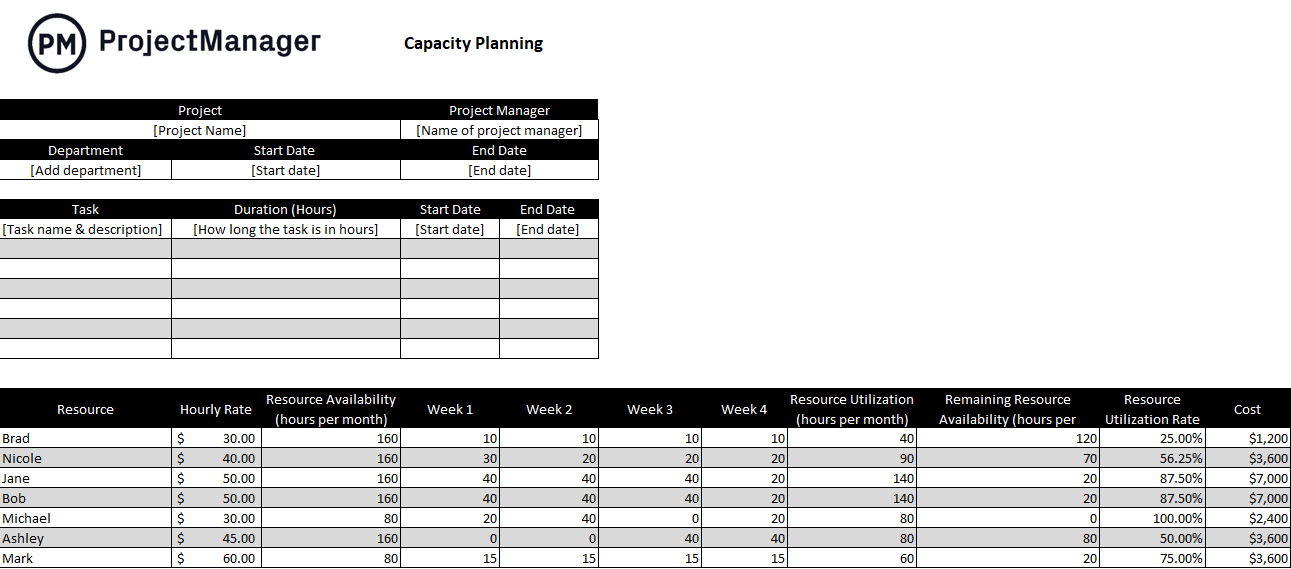
What Is Capacity Planning Software?
Capacity planning software is equipped with resource management tools that allow organizations to allocate resources for the execution of work, monitor resource utilization and availability and track costs.
Here are some key capacity planning tools you should look for when choosing a resource capacity planning software.
- Task Management: Gantt charts, kanban boards, project calendars and other task management tools help organizations assign tasks to employees and track their progress.
- Resource Scheduling: Ideally, the task management tools in capacity planning software should offer features to make a resource schedule, which indicates how resources are allocated for the completion of tasks over time.
- Cost Management: Any capacity planning software needs features to track the costs that are incurred as resources are utilized so they don’t go over their project budgets.
- Time Management: Time tracking tools like timesheets and dashboards help track the work hours of employees for cost tracking, performance monitoring and payroll processing purposes.
- Workload Management: Workload charts help managers and team leaders ensure tasks are evenly distributed among employees to maintain an optimal resource utilization rate and identify gaps between capacity and workload.
- Resource Management Reports: Reports help project teams and operations managers understand how resources are being allocated as projects are executed.
Why Is Capacity Planning Important?
Capacity planning is important as it ensures a business has what it needs when it needs it to fulfill demand. It allows for flexibility to help make a wide range of products and, done properly, it ensures that no extra money is spent on the effort.
Budgeting and scaling are guided by capacity planning, which helps identify optimal levels of operations. For example, you can determine what services are offered and what the timeframe and staffing requirements will be so you can cover your operational costs.
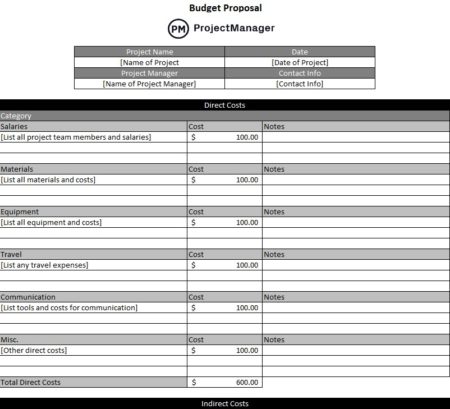
Beyond those reasons, capacity planning helps managers make more informed decisions. It also helps employees by avoiding burnout or boredom on the job. As mentioned, it’s crucial to help a company grow and assist in making better staffing decisions.
Importance of Capacity Planning in Operations Management
As defined, capacity planning is used to determine the amount of work an organization can do over a specific period. Operations management is about planning, organizing and controlling resources to deliver products and services.
Therefore, capacity planning is a critical aspect of operations management as it helps determine what must be done to meet the demand for that product or service. It also sets up a company to grow, while avoiding idle resources and underused capacity.
Importance of Capacity Planning in Project Management
Project management is the planning, managing and controlling work over a determined time that results in a deliverable. This is achieved through the execution of tasks that require both human and non-human resources.
Capacity planning is a critical component of project management as a project schedule and budget are created. It helps project managers figure out the necessary capacities in terms of those resources, especially team members, to meet the project deadline and stay within budget.
Importance of Capacity Planning in Production Management
Production management is the process of turning raw materials, human resources and capital into a production output. It involves planning and controlling industrial processes to make sure production runs smoothly.
Capacity planning fits into this process in three ways. There’s production capacity planning to make sure you have enough product or materials for deliverables. Workforce capacity planning deals with your human resources and work hours, while tool capacity planning ensures that your workers have what they need to do their jobs.
Capacity Planning vs. Resource Planning
While the terms “capacity planning” and “resource planning” are sometimes used interchangeably, they’re not the same. To understand the differences, we’ve listed them below.
Capacity Planning
- It’s a strategic planning process designed to help determine if the organization has the production capacity required to meet the demand
- It looks at resource availability at the skill set/team level
- Then it facilitates the decision-making process to hire resources or defer/approve/cancel projects
- Capacity planning is about supply and demand
Resource Planning
- It’s a strategic planning process that coordinates and allocates actual resources to project tasks based on resource requirements
- It provides a plan to project managers, which resources they can plan to use for their projects and when
- Resource planning focuses on resource allocation
Capacity Planning Benefits
Production capacity planning is an important strategic planning process for many reasons. Here are some of the main benefits of effective capacity planning.
- Reduces costs
- Prevents stock-outs
- Reduces production lead time
- Eliminates excess capacity
- Helps with supply chain management: A clear understanding of your project capacity requirements helps you get the right amount of resources, which benefits your supply chain.
- Helps with resource management: Having the right production capacity to meet your capacity requirements is key to optimizing resource planning and resource allocation.
Capacity Planning Best Practices
Here are some tips and capacity planning best practices to help you manage your resources and teams.
- Establish a cross-functional team: To collaborate and communicate about production capacity and resource management, you want a cross-functional team with different levels and different functions.
- Calculate resource capacity: Before you can create a production capacity plan, you need to have an idea of your current capacity and your available resources.
- Determine resource requirements: For each project, look at the scope and what resources are required to do the task for the project.
- Prioritize projects: Which projects are most important, and which can be put aside for the time being? You can’t do everything at once.
- Allocate resources based on project priority: Now allocate those prioritized projects and ensure they’re aligned with the goals of the organization.
- Keep the lines of communication open: Communicate between executives, project management leaders and stakeholders.
- Document known risks: Monitor risks such as union strikes, weather and government regulations that stop a project or create new ones unexpectedly.
- Plan for how to handle too much capacity: Understand where it is and how to resolve it (such as reassigning), or not enough capacity (again, where/how).
ProjectManager Is a Great Capacity Planning Tool
Capacity planning requires the right resource management tools to give managers insight into their production capacity. ProjectManager is online project management software that gives them real-time data to make real-smart business decisions.
Make Interactive Resource Schedules
ProjectManager’s Gantt charts are ideal for making schedules to plan resources and track their costs in real time. Map tasks on a visual timeline, assign them to your team members and track their work hours. Set a baseline and then use real-time dashboards to monitor the actual utilization of resources as compared to the planned resources.
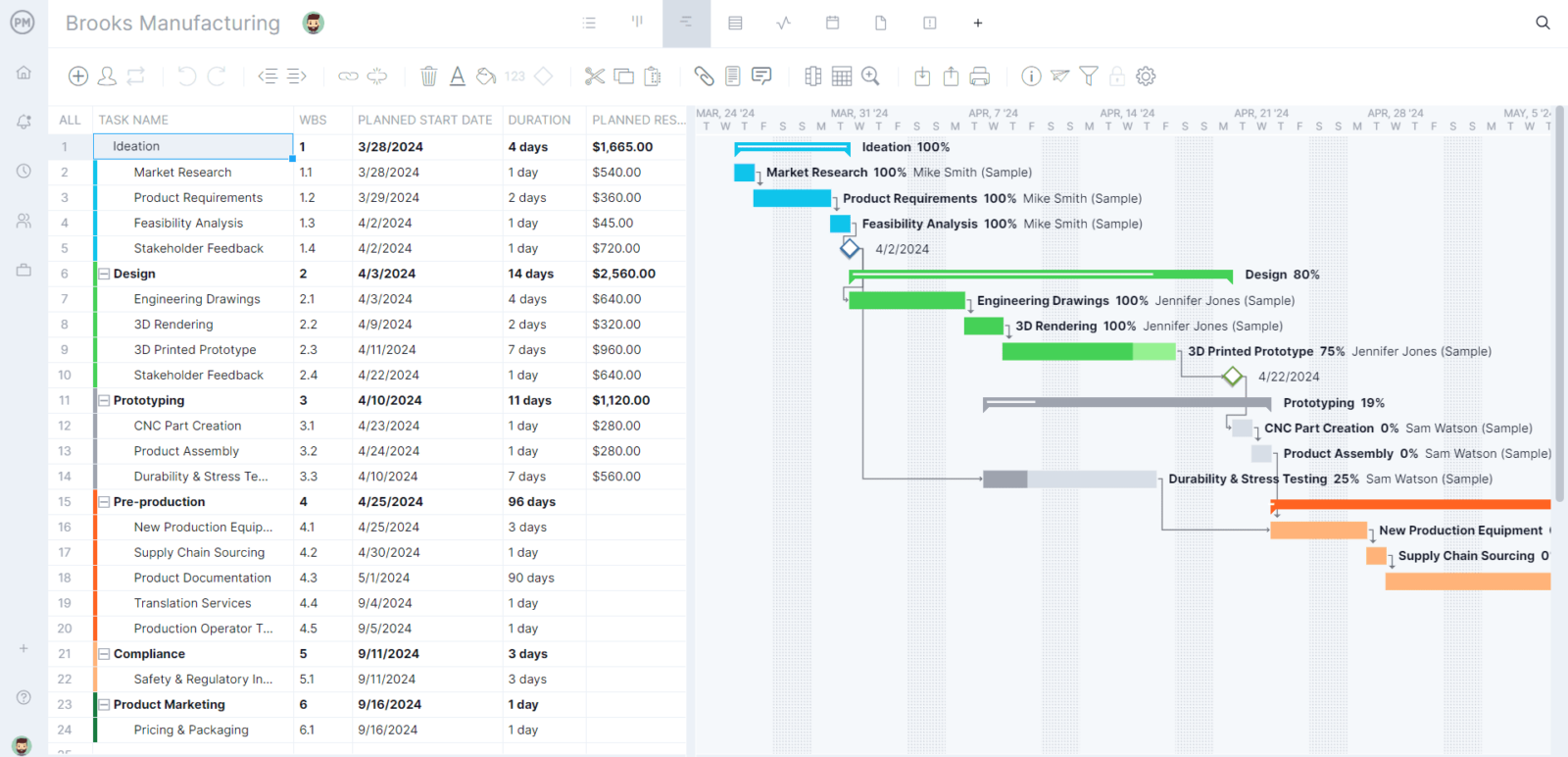
Track Progress, Time and Costs
To get a full picture of the costs involved, you can add hourly rates for your teams and contractors across your project or portfolio. As team members log their hours using ProjectManager’s task management tools, labor costs are automatically calculated and reflected in timesheets, dashboards and other project management views.
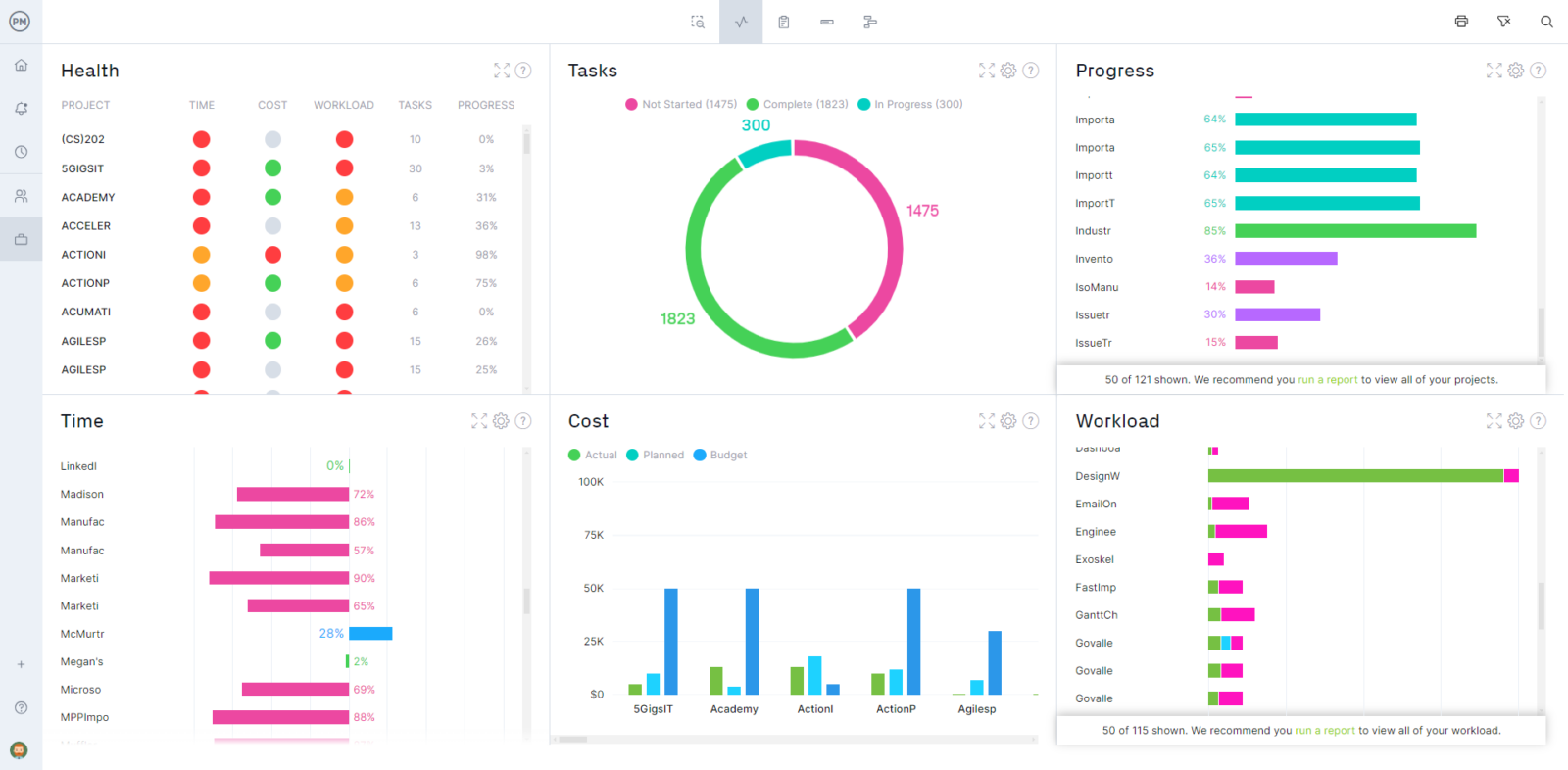
Balance Your Team’s Workload
ProjectManager’s color-coded workload management chart shows how tasks are distributed among team members making it easy to identify who’s over or underallocated. Then use ProjectManager’s resource planning tools to balance the team’s workload and keep teams working at capacity.
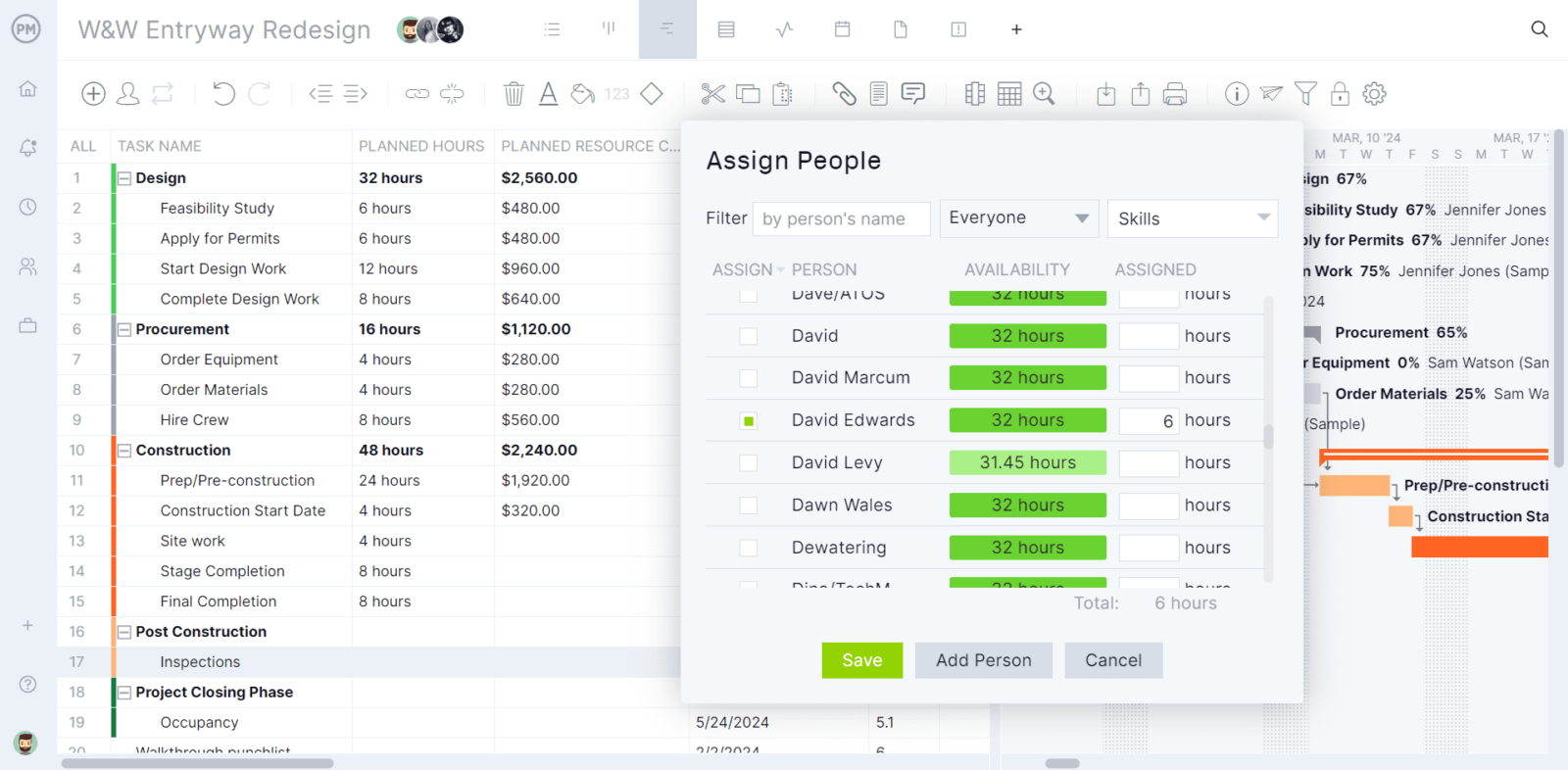
Capacity Planning Video
Want to learn more about capacity planning? Watch the video below from Jennifer Bridges, PMP. Although her video focuses on IT teams, capacity management lessons can be applied to any industry.
Here’s a screenshot for your reference!
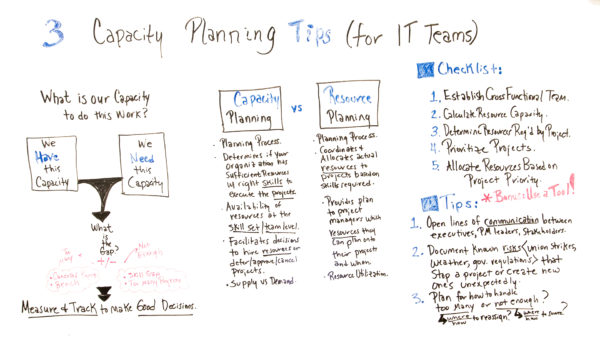
Thanks for watching!

